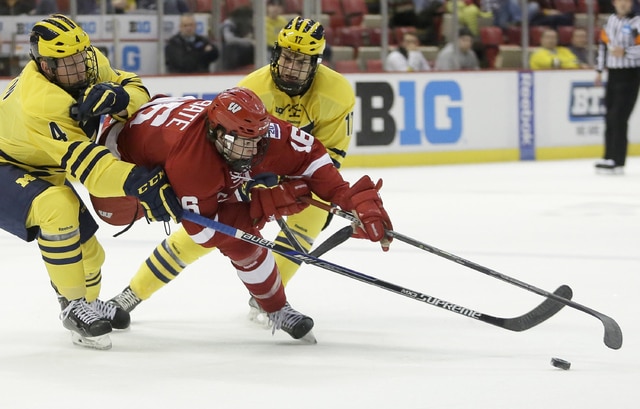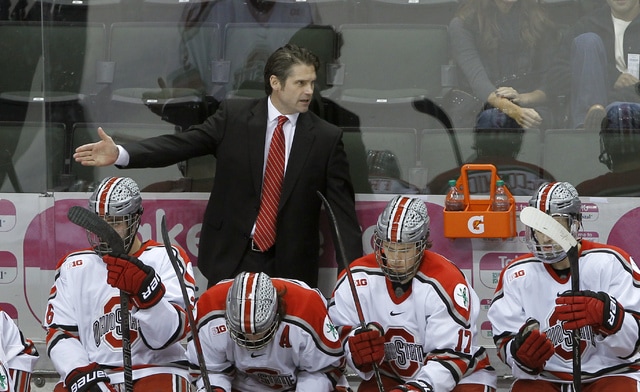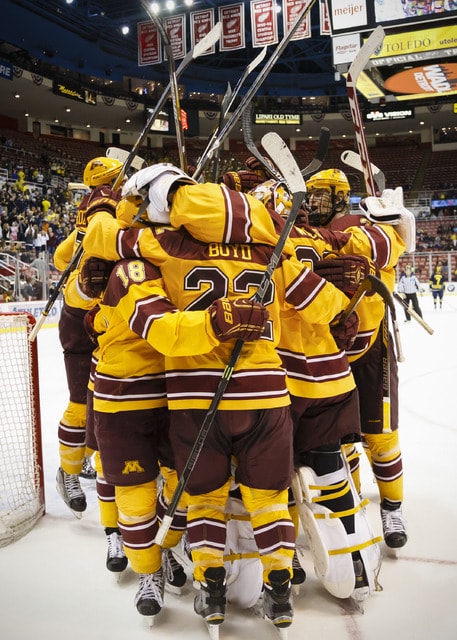


Big Ten hockey has not been much of a force in its first three seasons. That hasn’t stopped the conference from throwing a few elbows in the insular world of college hockey.
The only Power Five hockey league was formed after Penn State added a program in 2012, giving the Big Ten the six teams it needed.
With the exposure provided by the Big Ten cable network, abundant resources and strong traditions in the sport, the league was set up for success. Officials are confident it will come in time, and also believe the strength of the Big Ten brand will nudge the sport closer to the mainstream and spur expansion to other big-time schools.
But along the way, the Big Ten has tested the traditional collegiality among Division I hockey’s 60 schools, a third of which are Division II or III in their other sports.
One league, the Central Collegiate Hockey Association, folded after the Big Ten stepped on the ice. The Western Collegiate Hockey Association is a shell of its former self and bleeding money since Minnesota and Wisconsin left. Six other former WCHA schools — including 2015 Frozen Four participants North Dakota and Nebraska-Omaha — left to start the National Collegiate Hockey Conference because of concerns they would be overshadowed by the Big Ten if they stayed.
And most of college hockey has aligned against the Big Ten over a recent proposal it unilaterally submitted to the NCAA that would impact the eligibility of older freshmen, who are commonly found on rosters across the sport.
“The Big Ten change was imminent, and I wouldn’t tell them how to do their business,” said Northern Michigan coach Walt Kyle, whose Wildcats went from the CCHA to WCHA. “I think the rest of the change around college hockey wasn’t imminent. It didn’t necessarily have to happen. I don’t think all of this has been healthy for college hockey, and if you look at the numbers, they’ll reflect that.”
The new WCHA is made up of 10 teams — holdovers, former CCHA members or independent. The league stretches from Alabama and Alaska, and its travel costs have increased an average of 40 percent since realignment.
The six-figure distributions the old WCHA paid to schools in its heyday — significant to small-time athletic departments — have dried up the last two years because the league’s postseason tournaments have lost money or netted no profit. In addition, smaller schools no longer get the extra ticket revenue they counted on when Big Ten teams regularly visited their arenas.
WCHA Commissioner Bill Robertson said he wants to expand from 10 to 12 teams and split into divisions to cut travel costs. Meanwhile, WCHA members pour more institutional dollars into their programs to reduce the shortfall.
“They’re all committed to hockey,” Robertson said. “It’s a staple at their universities. The athletic directors and head coaches are dedicated and willing to do whatever it takes to make this league as good as it can be.”
Travel costs are high in the NCHC as well, especially for eastern-most members Western Michigan and Miami (Ohio). More realignment may be in store if those two schools look to trade airplane trips west for bus rides to closer opponents.
“It makes too much sense for there not to be movement by some schools to re-create a CCHA-type league at some point,” said American Hockey Coaches Association executive director Joe Bertagna, also the Hockey East commissioner.
The Big Ten, meanwhile, is trying to get its legs. Attendance has declined since the league formed and fans have lamented lost rivalries. The league’s nonconference record this season is 39-39-10, and only Michigan (19-4-5) is in the top 10.
“Has Big Ten hockey measured up with what fans’ expectations are? It may not have in many cases,” Big Ten associate commissioner for hockey Brad Traviolia said. “I think we’ve got very good hockey going on in the Big Ten and we’re going to build on it.”
The BTN is televising 22 games this season, down from 29 a year ago, and a few games are on ESPNU. The exposure is unprecedented.
“I hope the Big Ten can give a push to other schools,” Ohio State coach Steve Rohlik said. “Will it be more Big Ten schools? Are we going to go out West or down South? There are a lot of kids playing hockey in California and Arizona now. Maybe that’s where the growth will be.”
Arizona State is in its first season as an independent and plans to go into a conference in two years. The WCHA and NCHC already have talked to the Sun Devils, as has the Big Ten, which could take ASU as an affiliate member for hockey.
While that sorts out, college hockey is still roiling after the Big Ten in September proposed legislation that would penalize players who delay their initial college enrollment more than two years after their high school graduations. Every year delayed past that point would cost the player a year of eligibility; most of the players affected would be 21-year-old freshmen.
It’s common for a player to spend three seasons in the junior ranks before enrolling. Of the 490 freshmen in Division I hockey this season, 132 (26.9 percent) were 21 as of Oct. 1.
Traviolia said the proposal’s intent is to draw the sport closer to the traditional collegiate model of having 18- to 22-year-olds participating as opposed to having upperclassmen in their mid-20s. Traviolia said he’s aware that some coaches believe the Big Ten, whose teams have significantly more 18- and 19-year-old freshmen, wants to make the game younger to offset a possible competitive advantage for smaller schools that tend to have older freshmen.
Coaches in Atlantic Hockey, the NCHC and WCHA are unanimously against the proposal, and the majority of coaches in Hockey East and the Eastern College Athletic Conference are opposed. The Division I Council will vote in April.
Northern Michigan’s Kyle hopes the freshman-entry proposal isn’t the start of a Big Ten power grab in hockey. Kyle noted that most of the Big Ten coaches have worked at small hockey schools and understand the challenges.
“I want them to understand how much we need them to help us,” Kyle said. “You can help college hockey as a whole, or you can stratify it.”




